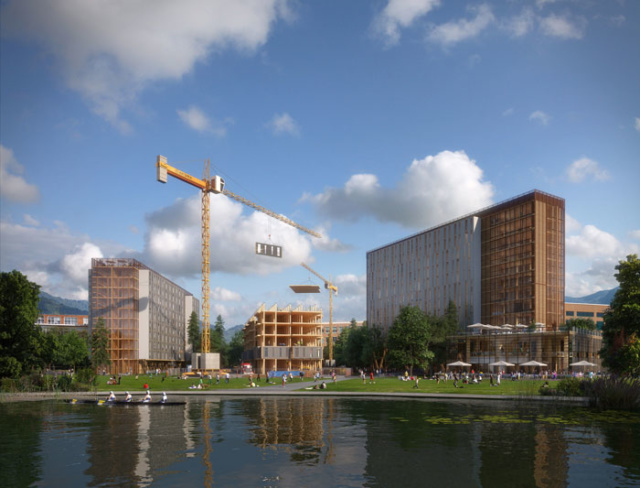
“Every building shouldn’t be a one-off prototype.”
That’s an underlying and provocative premise behind Katerra, a technology company that’s on a mission to optimize the way buildings are developed, designed, and constructed. Truth be told, the industry is primed for an overhaul. Construction companies traditionally invest less than 1 percent of revenue in new technologies—lower than every other major industry, according to the company’s literature. As a result, simultaneous productivity decreases and cost increases during the last several decades have created a quandary that requires fresh thinking and outside-of-the-box solutions.
“The one thing that’s become very apparent is that—and this is typical in an up-cycle—it’s very difficult for architects and contractors to keep up with material costs, with cost escalation in these upturn markets,” explained Craig Curtis, FAIA, Architecture, Interior Design at Katerra. “And if you couple that with the fact that the skilled labor shortage is becoming more and more critical, where we’re headed right now as an industry I think is kind of a train wreck.”
To help avert such a debacle, Katerra is completely rethinking the existing construction model and replacing it with technology, design, and supply chain innovations that aim to revolutionize the world of architecture and construction.
The Silicon Valley Approach to Building
“What we’re trying to do is take on every aspect of the entire process as the Silicon Valley way of looking at an industry so that it’s not just focused on supply chain, which is where we started,” Curtis explained. “We’re really looking at from initial site concepts to own the process all the way through design, through component design, manufacturing drawings, offsite manufacturing, and final site assembly—the entire package all in one with one hand to shake.”
For those who cringe at the term “mass customization” and shudder at the thought of a skyline full of banal, indistinguishable prefabricated structures, take heart: Katerra is, at its core, a company in the business of preserving and improving the design process, rather than dismantling it.
“We’re a design-first company here,” Curtis noted. “This is not a company that is producing cookie-cutter-looking buildings; the cookie-cutting part of what we’re doing is all stuff that can easily be redundant without affecting the beauty of the architecture,” he continued. “So, we’re really concentrating on making sure that everything we do allows for that customization of not only the experience inside, but also how the building fits into a particular culture or climate or place.”
In other words, Katerra does not build prefabricated modules or completed hotel room pods, for example, and truck them down the highway on a flatbed. Rather, Curtis said the company takes a cue from global furniture giant IKEA to flat-pack building materials and interior components to improve logistics and reduce shipping costs. By doing so, it offers greater flexibility in the final look and feel of a building and allows architects to do more of what they do best—not less.
“By optimizing a lot of the interior and the systems that are within these buildings, we’re actually finding that as architects, we have more time to spend instead of less time to spend on the thing that really matters and that’s: What does the building look like and how does it fit into a community?” Curtis said. “We’re not spending all that time redrawing bathrooms or mechanical systems or electrical layouts because that’s done; it’s repetitive. A lot of that work can be done in the computer,” he added.
Executing the Design
Katerra operates under another premise as well: “A transformative approach to building begins with design.” As such, the company developed a novel building system to strike a balance between standardization and configuration. Based upon a standard kit of parts, Katerra’s design system utilizes structural building components and curated interior products and finishes to create a multitude of elegant, custom configurations, according to company literature.
Katerra’s BIM modeling links directly to its global supply chain through proprietary technology to ensure ease of ordering, tracking, and manufacturing. Its integrated logistic network, global product sourcing, and manufacturing teams reduce the number of suppliers and manufacturers, creating aggregate demand that establishes negotiating power to the benefit of clients. The company’s end-to-end building process mimics the process of precision-sequenced product assembly, moving labor from the job site to its factories, promising improved schedule and product quality assurance.

“We have customers who are very interested in having a partner who can create a more systemized approach to what they do and just streamline the process from the very beginning,” Curtis explained. “Instead of every single project being bespoke and starting with an entire new team, which is what the industry has been forever, we can become their partner and help them develop their systems, building tools, and custom assemblies suited for their operation and what they do and what they do well, and help them execute that faster and cheaper.”
